San Diego Symphony Soars with All-Mozart Concert in Del Cerro
Saturday at PHAME, the auditorium at Patrick Henry High School in Del Cerro, Music Director Rafael Payare led the San Diego Symphony in a highly satisfying all-Mozart concert. Slimmed down to a chamber orchestra of strings and a handful of winds, the orchestra served up three Mozart Symphonies with abundant spirit and stylishly nuanced execution.
The moment Payare and the Symphony launched into Mozart’s early Symphony No. 29 in A Major, K. 201, I was struck by how much I had missed experiencing the orchestra’s immediacy and clarity in a resonant room while seated some 20 feet away from the conductor. This fall, while Copley Symphony Hall has remained closed for significant reconstruction, we have enjoyed the Symphony’s concerts at the Rady Shell, a superlative outdoor venue with a sophisticated sound system that captures and majestically projects the power of the orchestra. And I do appreciate work of the projection team that focuses on first-chair players and sections that are playing solos, projecting these visual close-ups on the giant screens.But a sense of presence within the sound eludes even the best sound systems, however, not to mention subtle aspects such as the string players’ barely audible scrape executing a sharp down-bow; the aural complexity of a trumpet’s fortissimo attack, or the mellow shimmer of a sustained note from a horn player. Payare was closer to his players and closer to his audience at PHAME, which projected, in my estimation, a more tangible sense of community on both sides of the stage. I know I am not alone hoping that the remodeling of Copley Symphony Hall—which is intended to bring the entire main floor audience into closer proximity to the orchestra—will be completed this spring. April is the target month, and I will light a candle or two for its completion and re-opening.
Payare gave Mozart’s Symphony No. 29 a welcome intimate feeling, coaxing lithe, gently sculpted phrases from the orchestra, which displayed a catalogue of subtly differentiated dynamic levels that the hall’s fine acoustics accommodated splendidly. The eloquent Andante movement revealed the strings’ beautifully focused ensemble buoyed by generously supportive phrasing from the oboes and horns. Mozart supplied plenty of “Mannheim rockets,” those quick, unexpected ascending arpeggios, for his high-spirited Finale, Allegro con spirito, that gave a bold conclusion to this refined symphony.
When Mozart premiered his Haffner Symphony in Vienna in 1782, it not only won generous applause from the unusually large audience in attendance, but the Emperor—who was present in his royal box—sent the composer a tidy monetary gift afterwards to indicate his approval of the Symphony. For good reason this work is one of the composer’s most frequently performed symphonies, and Payare and the orchestra played it with finesse to charm royalty, although I did not see San Diego’s mayor in the hall.
Payare asked for drama in the Haffner Symphony’s outer movements, and the orchestra responded mightily. Of course a larger wind section topped off with trumpets and timpani made this demand easier to fulfill, especially in a hall that seats just under 500. But the orchestra was not all muscle. In the slow second movement, we enjoyed elegant themes accompanied by deft pizzicato strings. To his credit, Payare adroitly navigated the sparkling contrasting themes of this ingratiating movement.
Mozart wrote only two symphonies in a minor key, but ironically, his Symphony No. 40 in G Minor has won him the greatest adulation since its premiere in 1788, and many historians see this symphony as the musical bridge from the Classical era symphony to the symphonies of the Romantic era. Payare took the composer at his word with his quite brisk tempo for the opening movement, Allegro molto. Fortunately, his “molto” was not too much for the orchestra, and the musicians responded with confident drive and fervor. And he allowed sufficient time in the Andante to linger over its intimations of mystery that simmer beneath its calm surface. The orchestra’s ebullience displayed in this Symphony’s two final movements aptly crowed the afternoon’s musical offering.
This concert was presented by the San Diego Symphony at Patrick Henry High School in San Diego’s Del Cerro neighborhood on Saturday, January 27, 2024.

Ken Herman, a classically trained pianist and organist, has covered music for the San Diego Union, the Los Angeles Times’ San Diego Edition, and for sandiego.com. He has won numerous awards, including first place for Live Performance and Opera Reviews in the 2017, the 2018, and the 2019 Excellence in Journalism Awards competition held by the San Diego Press Club. A Chicago native, he came to San Diego to pursue a graduate degree and stayed.Read more…

